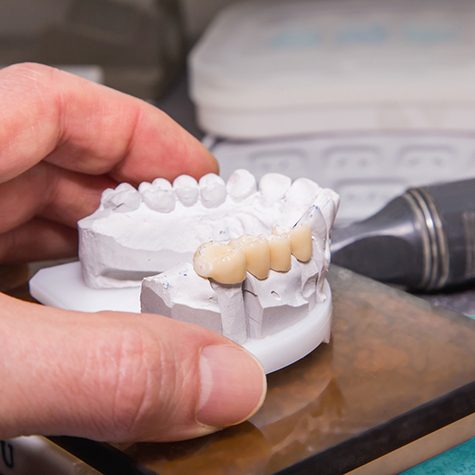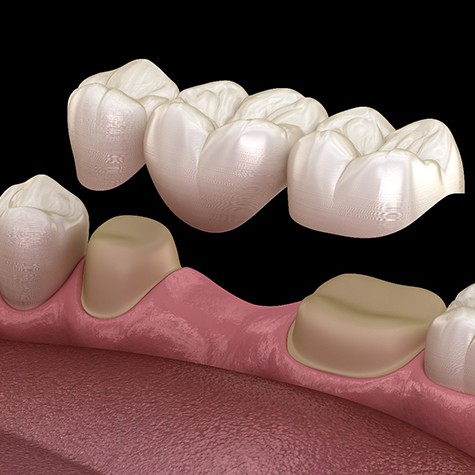SMILES 4U
Doylestown, PA 18901 (215) 345-6500 REQUEST AN APPOINTMENT
When opening your mouth, what is the first thing you see? If it is a gap because of multiple missing teeth, you may experience more than just embarrassment. Performing even the simplest tasks each day (i.e., eating, speaking, smiling) might also cause many difficulties. With the help of Dr. Olga Kandov, however, you no longer have to face these types of challenges. By having a customized dental bridge created and secured into place inside your mouth, you can take back your appearance as well as your oral health and function. Call us to schedule an appointment and learn more about these reliable prosthetics.

A dental bridge is a customizable prosthetic that is designed to fill in the gaps in your smile. When missing one or more teeth, Dr. Kandov can create a functional appliance that fits inside the mouth and allows for eating, speaking, and smiling. Combining two dental crowns that are secured on top of two healthy abutment teeth, the remaining part of the bridge consists of pontics (artificial teeth) that rest on top of the gums.

Apart from the traditional dental bridge style, many patients are unaware there is another option – an implant bridge. When meeting with your dentist, she will go over the two types you can choose from:
The traditional bridge has been used for decades and continues to be a reliable option for dentists to recommend to patients suffering from tooth loss. It is ideal for patients who have lost a few consecutive teeth in a row.
These bridges require two dental crowns to sit over healthy abutment teeth that are filed down to allow for a comfortable fit. Serving as anchors for the remaining bridge, these teeth hold the bridge in place. The two crowns are fused with pontics, also known as artificial teeth, which sit on top of the gums to fill in the gap and recreate a beautiful smile.
With proper care, these prosthetics can last up to a decade.
The alternative to a traditional bridge is one that is held in place by dental implants. Also referred to as an implant bridge, these prosthetics consist of two implant posts that are placed directly into the vacated sockets and secured to your jawbone. After 3-6 months of healing and allowing the bone and implants to fuse, a customized dental bridge is created and placed on top of the abutments that connect to the implant posts.
This type of prosthetic offers a permanent solution that can last 30+ years with regular maintenance.

Many patients do not realize the immense benefits that can come with dental bridges, some of which include:

Want to learn more about dental bridges? You’re in the right place! There are a few ways you can find the answers you’re looking for. First, you can give our team a call so we can help you directly. Second, you can keep reading to learn the answers to a few of the most frequently asked questions we hear from patients about dental bridges.
Typically, dental bridges last anywhere from 5 to 15 years. The longevity of yours will largely depend on your diet, lifestyle habits, and oral hygiene regimen. For example, if you eat a lot of sweet foods, smoke, and don’t floss consistently, then there’s a good chance your dental bridge will only last for a few months or years. If, on the other hand, you eat nutrient-dense foods, refrain from poor dental habits, and follow a solid dental care routine, then your dental bridge can last for well over a decade. Note: implant bridges can last even longer – they’re known for lasting 30+ years!
Dental bridges can replace one missing tooth or a row of missing teeth. The most they replace are four, however. Extending the bridge past that causes it to become unstable, negatively impacting your bite. If you’re struggling with more moderate tooth loss or you need to replace several teeth throughout your mouth, then we can review your other treatment options, like dentures and dental implants.
In short, the answer is “no.” While your natural teeth are made of enamel, dental bridges are crafted from materials that cannot be whitened. The best way to keep yours nice and bright is by following a solid dental care regimen (i.e., brushing twice a day, flossing daily, getting a dental cleaning biannually). If you become unhappy with the shade of your dental bridge over time, then don’t hesitate to talk to your dentist about your treatment options.
They do! Modern dental bridges are crafted from lifelike materials that blend in seamlessly with your existing smile. If you previously had noticeable gaps in your smile, then your friends, family, and colleagues will notice a difference, of course. However, all of the attention your smile receives will be positive.
No, dental bridges cannot get cavities. Your surrounding teeth and gums are still vulnerable to decay and infection though. That’s why it’s of the utmost importance that you continue to prioritize your oral hygiene regimen.
Dental bridges are lifelike, durable, and stable, ensuring they benefit the look and function of your smile. While you’ll be able to eat whatever you’d like, it’s a good idea to exercise caution with extremely hard, sticky, and chewy foods. A few that make the list are peanut brittle, popcorn, and caramel apples. Instead, opt for nutrient-dense options like fresh fruit, cooked vegetables, lean protein, and soft carbs (like rice).